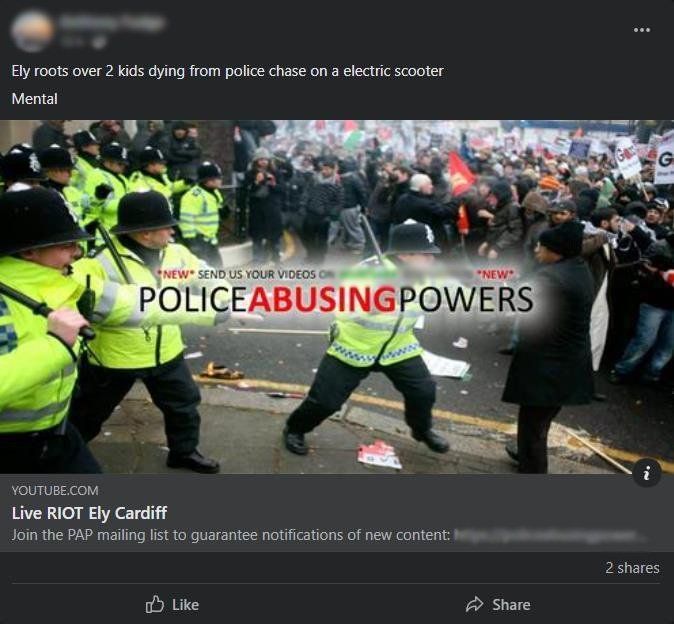
Misinformation meant there were varying accounts of what happened on social media
A riot which erupted following the deaths of two teenagers shows how police forces struggle to cope with the social media furore that follows, experts say.
Kyrees Sullivan, 16, died alongside his best friend Harvey Evans, 15, in a crash in Ely, Cardiff, on Monday.
Allegations spread rapidly that a police van had been chasing them and several hours of violence followed.
Nine arrests were made while 15 officers were injured.
Image source, Getty Images
A riot broke out in the Cardiff suburb shortly after the boys died in a collision
Following the crash which claimed the boys’ lives shortly after 18:00 BST on Monday, social media posts spread swiftly.
One person wrote: “The FACT is that they were being chased by the police.”
Another said: “Apparently police were chasing two kids and then they got run over by a bus?”
Violence quickly erupted, with cars set alight and fireworks thrown at police as crowds gathered.
The following morning, police and crime commissioner Alun Michael claimed there was no police chase – but then CCTV footage emerged appearing to show a police van following the boys. He later denied he had been misinformed.
The incident has raised questions about the ability of the police to counter social media rumours.
At least two cars were torched as flares were set off on the night of the riots
Professor Matthew Williams, chair in criminology at Cardiff University’s School of Social Sciences, said: “In any riot or large-scale disturbance, reasons like deprivation, lack of opportunity and distrust in police might well be cited.”
He added that while social media did not cause the riot, it may have “accelerated things”.
“The immediacy of the riot might be a key part of social media’s influence,” he said.
“The pace of it is much more rapid and it can collapse the timeframe where police communication or dialogue with the community can happen.”
Some experts feel the police should have countered the rumours quicker
Policing and crime commentator Danny Shaw said with an independent investigation underway people should avoid speculation.
“Social media can be a real problem for policing in general because claims, whether false or otherwise, can be spread very quickly.
“That can inflame and exacerbate existing tensions and police have to deal with that – particularly if those claims involve the police themselves.
“A report, a video, an image can be uploaded and posted around the whole world within minutes. Issues can be amplified in a way that didn’t happen before.”
Danny Shaw says social media can be a ‘real problem’ for police
Former chief superintendent Gerry Toms began his Cardiff posting the day after riots broke out in the same area back in 1991.
The Ely bread riots saw a general store run by a Pakistan-born shopkeeper on Wilson Road pelted with bricks and rocks.
Three nights of unrest followed, with up to 500 people facing off with 175 police officers in riot gear.
Although he did not police the riots, Mr Toms remembers: “In those days they had to spread by word of mouth, and that takes time.
“Whereas today, social media is exactly that – if I want to make a comment about something I’ve seen or something I heard, I do it, I press the button. It’s instantaneous.”
Shops on Wilson road in Ely were at the epicentre of the Ely riots
He labels social media as a “double-edged sword”, highlighting its benefits to the police.
“It’s an excellent way for the police themselves to be able to talk to people in a very broad sense in an accurate way,” he said.
Mr Toms added that people need clarity after an incident such has the crash in Ely.
Image source, Gerry Toms
Former senior police Gerry Toms says social media means views are spread instantaneously
“It wasn’t clear. If we’d use the word followed – because clearly evidence came out that morning that they had been followed – there is clear evidence that it was a police vehicle behind those youngsters.
“So maybe the message that came out from the police early wasn’t clear enough to satisfy the people of Ely, and in fact in the broader public, that the police had perhaps acted improperly in some way.”
South Wales Police were not the only ones struggling to control social media misinformation
Misinformation on social media was not just a problem for the police.
Cardiff Bus was forced to post its own statement online after suggestions one of its vehicles was involved.
It said: “This is not the case. We have already asked newspapers and other media outlets to correct this mistake, but wanted to release this statement so the community knows that none of our vehicles were involved.”








